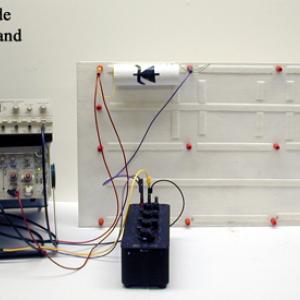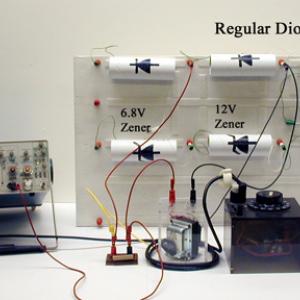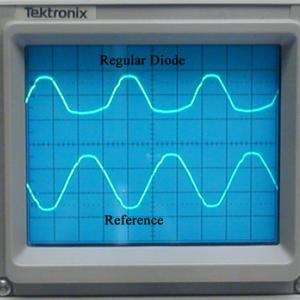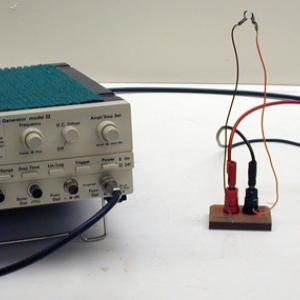College of Liberal Arts & Sciences
5M10.50 - Principles of a Diode
Hook the positive output of the generator to one end of the diode, the other end of the diode to one end of the resistor, the other end of the resistor to the negative output of the generator. Now you have you basic circuit. Measure across the diode and the resistor as shown using the resistor as a reference. The diode will allow voltage to pass through the circuit when inserted one way and will prevent it or decrease it drastically when inserted the other.
Other types of diodes may be inserted into the circuit to show their unique characteristics.
Connect the bi-color LED to the wave generator. At very low frequencies the alternating AC sine wave will be shown visibly.
A resistor box may be inserted in place of the single resistor shown for circuits using the wave generator.
For circuits using the Variac you must use a power resistor.
- Tom Ekkens, "An Inexpensive Semiconducting Device Laboratory: Building a Schottky Barrier Diode", TPT, Vol. 58, #1, Jan. 2020, p. 64.
- Victor E. Henrich, "Gravitational Model of a p-n Junction", TPT, Vol. 56, #8, Nov. 2018, p. 538.
- Eugenia Etkina and Gorazd Planinsic, "Light-Emitting Diodes: Exploration of Underlying Physics", TPT, Vol. 52, #4, April 2014, p. 212.
- Jukka O. Mattila, "Reindeer Diode", TPT, Vol. 51, #1, Jan. 2013, p. 12.
- "Erratum", TPT, Vol. 43, #3, May 2005, p. 310.
- M. Camden, "Oscilloscope Display of Current-Voltage Curves", TPT, Vol. 7, #7, Oct. 1969, p. 406, reprinted in TPT, Vol. 43, #2, Feb. 2004, p. 121.
- Richard V. Mancuso and Elise M. Somerset, "Changing of the State of a Diode and Chaos", TPT, Vol. 35, #1, Jan. 1997, p. 31.
- Fred W. Inman and Dan Woodruff, "The Thermometric Property of a Diode", TPT, Vol. 33, #2, Feb. 1995, p. 120.
- Samuel Derman and Wallace T. Anderson, "Semiconductor Reliability - Another Field for Physicists", TPT, Vol. 32, #4, Apr. 1994, p. 226.
- Thomas A. Walkiewicz and James R. Kirk, "Characteristic Curves", TPT, Vol. 32, #2, Feb. 1994, p. 90.
- Thomas A. Lehman, "Light on LED's", TPT, Vol. 31, #5, May 1993, p. 262.
- Steven A. Waltner and Thomas A. Lehman, "When Is Ohm's Law Valid?", TPT, Vol. 31, # 2, Feb. 1993, p. 102.
- David G. Fisher, "Diode Characteristics to Determine Boltzmann Constant", TPT, Vol. 30, # 5, May 1992, p. 315.
- John W. Jewett Jr, "Get the LED Out", TPT, Vol. 29, #8, Nov. 1991, p. 530.
- Ray Watterson, "Tri-Color LED Demonstrator", TPT, Vol. 25, #4, Apr. 1987, p. 234.
- James E. Kettler, "Tri-Color LED Demonstrator", TPT, Vol. 23, #9, Dec. 1985, p. 558.
- J. Matolyak, R. Roberts, and R. Berry, 'Nonlinear Circuit Concepts - An Elementary Experiment", TPT, Vol. 21, #8, Nov. 1983, p. 522.
- M. Camden, "Oscilloscope Display of Current-Voltage Curves", TPT, Vol. 7, #7, Oct. 1969, p. 406.
- R. E. Alley, "Experiments with Semiconductor Devices", TPT, Vol. 3, #5, May 1965, p. 199.
- R. E. Alley, "Semiconductors and Semiconductor Devices", TPT, Vol. 3, #2, Feb. 1965, p. 55.
- F. Herrmann and P. Wurfel, "The Semiconductor Diode as a Rectifier, a Light Source, and a Solar Cell: A Simple Explanation", AJP, Vol. 74, #7, July 2006, p. 591.
- Jurgen W. Precker, Marcilio A. da Silva, "Experimental Estimation of the Band Gap in Silicon and Germanium from the Temperature-Voltage Curve of Diode Thermometers", AJP, 70, # 11, Nov. 2002, p. 1150.
- K. A. Denault, "Lighting with Laser Diodes", Physics Today, Vol. 66, #9, Sept. 2013, p. 18.
- Ashley G. Smart, "New Clues to LED's Efficiency Droop", Physics Today, Vol. 65, July 2012, p. 12.
- Earl R. Feltyberger et al., "Semiconductor Diodes", Teaching About D. C. Electric Circuits, p. 3.15.
- Earl R. Feltyberger et al., "Photon Emission By Light-Emitting Diodes (LED's)", Teaching About D. C. Electric Circuits, p. 2.6.
- Mark Davids, et al., "Physics of the Light-Emitting Diode", Teaching about Lightwave Communications, 1994, p. 2-2.
- Yaakov Kraftmakher, "1.4, I-U Characteristics", Experiments and Demonstrations in Physics, ISBN 981-256-602-3, p. 18.
- Donald E. Simanek, "Ode to a Diode", PIRA Newsletter, Vol. 10, #6, June 1996.
- Neil A. Downie, "Gravity Diode", Ink Sandwiches, Electric Worms and 37 Other Experiments for Saturday Science, p. 220.
- "Principles of Vacuum Tubes", Selective Experiments in Physics, CENCO, 1944.
- Keithley Instruments and Richard M. Fuller, "Physics Experiment # 6: The Study of the LED as a Light Detector", Series II.
- Curt Suplee, "To conduct or not to conduct", Everyday Science Explained, National Geographic, p. 92.
- W. Bolton, "The Diode", Book 4 - Electricity, Physics Experiments and Projects, 1968, p. 71 - 72.
Disclaimer: These demonstrations are provided only for illustrative use by persons affiliated with The University of Iowa and only under the direction of a trained instructor or physicist. The University of Iowa is not responsible for demonstrations performed by those using their own equipment or who choose to use this reference material for their own purpose. The demonstrations included here are within the public domain and can be found in materials contained in libraries, bookstores, and through electronic sources. Performing all or any portion of any of these demonstrations, with or without revisions not depicted here entails inherent risks. These risks include, without limitation, bodily injury (and possibly death), including risks to health that may be temporary or permanent and that may exacerbate a pre-existing medical condition; and property loss or damage. Anyone performing any part of these demonstrations, even with revisions, knowingly and voluntarily assumes all risks associated with them.




